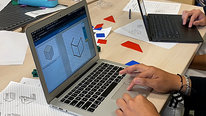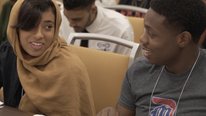CASER-ECSU: A Comprehensive Academic Scaffolding to enhance retention of mino...
P120A180034
2022 (see original presentation & discussion)
Undergraduate
Minority students from rural areas face a combination of challenges in their first year of college. Our MSEIP-supported project is aimed at addressing those key challenges by providing a comprehensive support starting from the summer before those students join Elizabeth City State University (ECSU), NC. Our project enables to do this through the implementation of 1) a comprehensive program that includes a summer, precollege bridge program that focuses on preparing minority students through a four weeks program to the rigors of and challenges of first year college experience, and 2) a continued close monitoring of academic progress of participant students through dialogue, their adjustment to college and providing academic and nonacademic support throughout the academic year. The ultimate measure of success for our project is the academic success as measured by their GPA and retention of participant minority students at the end of Semester I and Semester II.
Since 2018, the project has supported a total of 41 students in three cohorts starting in the summer of 2019. In all three cohorts, CASER-ECSU participant students performed better in their Biology and Math courses, and maintained a significantly higher semester and cumulative GPA than non-participant students. Above all, the retention rate for CASER-ECSU participants was consistently higher than it is for non-participants: first year retention was 80%, 85% and 100% for Year I, II and III, respectively.
Related Content for Enhancing retention of minority students at ECSU -CASER-ECSU
-
 2019ASK: Applying Scientific Knowledge
2019ASK: Applying Scientific Knowledge
Jason Deibel
-
 2022Pathways to STEM Success: The First Year Experience
2022Pathways to STEM Success: The First Year Experience
John Kaup
-
 2022Software to Increase Success, Diversity, & Retention in STEM
2022Software to Increase Success, Diversity, & Retention in STEM
Lelli Van Den Einde
-
 2019IN LSAMP: Faculty Mentors Prepare Tomorrow's STEM Workforce
2019IN LSAMP: Faculty Mentors Prepare Tomorrow's STEM Workforce
Michelle Quirke
-
 2020An Intervention to Improve Success of Biology Majors in Math
2020An Intervention to Improve Success of Biology Majors in Math
Parvaneh Mohammadian
-
 2019ASL Clear Project: Engaging Deaf Students in STEM Learning
2019ASL Clear Project: Engaging Deaf Students in STEM Learning
Jeanne Reis
-
 2017South East Alliance for Persons with Disabilities in STEM
2017South East Alliance for Persons with Disabilities in STEM
Overtoun Jenda
-
 2020IN LSAMP: Building Communities and Opportunities to Thrive!
2020IN LSAMP: Building Communities and Opportunities to Thrive!
Michelle Quirke

Eyualem Abebe
Marshall A. Rausch Distinguished Professor & Chair
Thank you for visiting the site and watching our video. This project is an expanded version of a pilot project which helped us test whether the implemented interventions in place would work at Elizabeth City State University. Although we dont explicitly state a theoretical framework for our interventions, we work with the framework of the Phenomenological Variant of Ecological Systems Theory where student stressors and risk factors are mediated by a set of interventions. We welcome comments and suggestions that may help us refine our work as we try to integrate these interventions into our First Year Seminar courses and experiences. Thank you
Eyualem
Neela White
Dr. Marci McMahon
Great video and such an important project! Thank you for all the work you do to support, uplift, and advance minority STEM students!
Eyualem Abebe
Marshall A. Rausch Distinguished Professor & Chair
Dr McMahon, Thank you for your positive comment. I think your team also doing a great work laser-focused on the HSI in STEM. The symposium is a great platform that seems to me unique in its focus. I think it can serve a great model for others. Thank you for what have established.
Gerhard Salinger
Former Program Officer
Hello. I am one of the facilitators assigned to this group of projects and a retired NSF program
officer. The CASER program has established strong evidence that the program helps to successfully retain students in their education. Congratulations. Have you evaluated which activities are crucially important to the successful results? Is it the activities in the summer program or are their also crucially important ongoing activities? Which of the activities could be included in a College-wide program to increase the success rate for all students and also be beneficial for the College?
Eyualem Abebe
Marshall A. Rausch Distinguished Professor & Chair
Thank you Dr Salinger. We have had qualitative and quantitative data on what students reported as the most impactful exercise while in the program. They report the activities of the summer bridge program to be the most impactful. Participants say they got a great start in creating lasting friendships, which helped them a lot during the most pressing early part of the first year. Also, knowing the faculty made them feel at home and were not nervous to ask questions when the need arises. We have done formal evaluation of the summer bridge program and the findings of the external evaluator is that it is impactful and helps the students adjust early. The various modules of the summer bridge program are subject matter focus (Math, Biology, Chemistry); Study Skills and Independent Study; Critical Thinking and Scientific Literacy; Academic Performance and Stereotype threat. The program is intensive and four weeks long. If not anything, it certainly helps many because most come with a largely exaggerated view of their academic abilities, study skills and time management. Once they go through the summer bridge program, we have seen time and again, their view changes.
Margie Vela
CEO & President
What a great program! I particularly like that you have engage students in a pre-college bridge program. I am very curious, how do you recruit the students?
The students in these cohorts seem to form strong bonds and it seems like the sense of belonging in higher education and in STEM are greatly impacted. Have you measured the students' STEM identity before and after the bridge program? If so are there significant differences?
Also, it would seem that the mentors also benefit from the program. Does you measure that impact? If so, how?
Congrats, again on a high impact program!!!!
Eyualem Abebe
Marshall A. Rausch Distinguished Professor & Chair
Thank you Dr Vela. Students are recuited without any grade criteria. The only critera is they must be rising freshmen at ECSU. Until now everyone who applied has been included in the program. The external program evaluator has a questionnaire on metacognitive measures etc..and a number of psychosocial aspects of the attributes are analyzed using that tool. Although it varied from year to year and among participants, generally there is difference between pre and post- data.
With regard to coaches/mentors, I know each of them weell (now personally) and follow each of them. I often write recommendation letters as they progress in their career goals. Some mentors are in PhD programs, some have graduated with MSc degrees, others are already in graduate degree programs. A number of times a participant in Year I has served as coach/mentor for Year II or III. These same students from the first cohorts are now in graduate programs. We also invite back many of these successful students to share their experiences with our participants. Two to four alumni (one per week) either come back (before COVID-19) or join through zoom each year during the summer bridge program.
Margie Vela
Courtnee Austin
Good morning! I definitely think the bridge program is awesome! Have you looked into partnering with other Universities in your area to expand the program? Specifically other HBCUs.
Eyualem Abebe
Marshall A. Rausch Distinguished Professor & Chair
Thank you for the comment,
No, we have not tried to contact HBCUs in the area. We did present our findings at NSF PI meeting twice whe we did the pilot project. We also present every year at the Department of Education MSEIP PI meeting.
I assumed other HBCUs know of these interventions. I also thought either it was used widely or didnot use it because they dont have the serious problems we have. But, if there is any need to help design any summer bridge, we can help. Some of the initial steps have taught us lessons and no one need to go through those again. On the other hand, others can build on aspects that worked well. So, I am open to anyone who may want to explore this. Thanks again.
Eyualem
Danielle Dani
The relationships that participants developed during the program are integral to retention! Using a cohort model, summer programming, and close relationships are effective strategies. Thank you for sharing.
Eyualem Abebe
Marshall A. Rausch Distinguished Professor & Chair
Thank you Dr Dani for your comment. I appreciate!
Eyualem
Tim Podkul
Senior Research Advisor
Thank you for sharing this work! As others have mentioned, the thoughtfulness of this approach and the use of the pre-college bridge program appears to be highly effective. I am also excited to see that you are taking a double-pathed approach to socializing the students in this program. You have created opportunities to socialize them within their cohort and thus strengthen the interpersonal bonds, which can give them a sense of belonging. Simultaneously, you are socializing them in a very concerted way to the academic departments and culture, through providing opportunities to focus on things like study habits that will be beneficial in this new environment. I hope more people recognize the strength of this model you have implemented!
I am curious about the onboarding of of the graduate student mentors? How are they selected and trained? Are there particular attributes or characteristics you look for when recruiting mentors? They are clearly doing an amazing job, and learning more about setting the mentors up for success as well would be welcomed!
Eyualem Abebe
Marshall A. Rausch Distinguished Professor & Chair
Thank you Dr Podkul,
We had undergraduate mentors/coaches as well as graduate student mentors. Selection of mentors was a long process. First I shared what I was looking for with the faculty and received nominations. Then I invited those students in the department who had the highest GPA with those nominated and had a one to one interview. Then I had a group discussion with all I screen after the one to one interview. I gave a training using a manual from the Nationl Mentoring Resource Center to those whom I decided to include in the team. The second year was easier becasue I included some from the first year and added one from the first cohort of participants. One summer only graduate students were available for the position. The characteristics I personally look for is GPA >3.5, excellent track record of interaction with other students in class, during labs, with faculty, especially their willingness to accept constructive criticism, general discipline, reliability and helpfulness. Some were doing research under faculty and such information was available. The program was so intensive in terms of the amount of time mentors had to spend with participants, only committed students were interested to participate. What I would like to add is we also monitored mentor progress over the years and we supported their growth through discussions on career options and supporting them in their applications to various graduate programs. It is rewarding to see all our mentors either have graduated or are currently in graduate programs.
Anita Crowder
Thank you for this project! Being an engineer myself with a daughter who is considering computer science and engineering, I understand how important these supports are for students. I look forward to reading more about your work!
Efe Frank
Good work done Sir. Please, how do you manage the number of students with respect to the available tools in the laboratory? Are the experiments done in groups or individually?
Thanks
Eyualem Abebe
Marshall A. Rausch Distinguished Professor & Chair
Our labs are designed to accommodate 32 students, the maximum our regular class size is. The cohort size of the summer bridge program was much lower than that, the largest was 23. In any case, we encourage students to work in groups for some activities and we require them to work individually on most skill activities. Career-exploration presentations are also indivually done.
Gerhard Salinger
Former Program Officer
You have done a very good job of telling us about what works. Could you also share with us some activities that did not work well and how you modified or replaced the activity?
Eyualem Abebe
Marshall A. Rausch Distinguished Professor & Chair
Thank you for the question. We we started the program our focus was on improving student performance in Biology courses, as the trigger to our work was a high attrition in Biology. But after one year, participants passed Biology but failed Chemistry. Then, we had to see all courses in a more comprehensive manner and that is how we added Chemistry to the summer program. Also, participants were very clear that virtual programs were not as effective because they reported that they were not able to focus virtually all day. We heard that comment in 2020 and in 2021 summer we impelemented a hybrid version where the first two weeks was virtual and the second was residential. Thirs issue was we started with discussions of about 90 minutes. But after the first year, that didnot work and had to be much shorter, if we were to keep students focused. We also were more discuss focued the first year but we realized it was not as effective as activities. So we implemented more heavily lab-based activities and those the participants loved. One thing is some of our participants didnot remain in STEM, instead they remained at ECSU and graduated but in a different major other than a STEM field. Reason seems to be the perceived amount of studying, and work STEM involves. This is largely with a small number of students who were really academically weak background.
Gerhard Salinger
Former Program Officer
Thank you
Further posting is closed as the event has ended.